gost 428502
Poznat
- Poruka
- 7.257
Donji video prikazuje kako da instalirate aplikaciju na početni ekran svog uređaja.
Napomena: This feature may not be available in some browsers.
Da, slažem se.
Kao što rekoh ovo je novije predanje, sasvim izvesno netačno( venecija itd).
Zna li se pouzdano da li je Milo Ozrinić ili je iz Cuca?
Da, znam za Đokovića.Jeste. Njegov djed-stric je Marko Djukanovic, predsjednik narodne skupstine Crne Gore u vrijeme kralja Nikole.
Ozrinicki Djukanovici vode porijeklo od Djukana Ivanova, unuk kneza Dragoja Ozrinica sa Čeva. Novak Djokovic potice od Damjana Vukasinova, drugi unuk kneza Dragoja.
Da, znam za Đokovića.
Znači i Milo je Ozrinić? Ako sam dobro shvatio ili?
Najviše pitam jer mi idu na živce ovi koji ne znaju, a teško im da provere pa nagađaju šta mu dođe blažo đukanović, četnički vojvoda iz Cuca.

Nikad cuo za ovo. Od kojeg je bratstva ovo predanje?
Cuce se dijele na Velje, Male Cuce, pa starince Srbi-Zecani i Mataruge.
Vecina plemena, Veljocuce imaju predanje da su od Pavla Orlovica i imaju zajednicki predak sa Bjelicama i Bajicama. Braca Cuko Bjelo i Bajo, naselili u Rzani Do i gradili zaduzbinu Orlovicku crkvu posvecana krsnoj slavi Orlovica sv Jovanu, smatra se za najstariju crkvu u Katunskoj Nahiji i Cucama.
Orlovici su drzali knezevstvo u Cucama bar od pocetka 17-og vijeka do ukidanja knezevstva 1852. godine.
Malocuce su od Kuča sa Meduna i dosli kasnije krajem 17-og vijeka.
Veljocuce su J2a, Malocuce E1, starinci su I2a, R1a i E1. Ovaj J2a je jedini marker povezan sa italijom.
Ovo predanje o venecijanskoj princezi sa kraja 15og vijeka tesko bi moglo biti tacno, s'obzirom da Pjesivci koji dijele zajednicki J2a predak sa Veljocucama, a spomenuti su kao pleme u ugovoru sa Stefanom Crnojevicem 1455. godine.
Vjerovatnija teorija jeste da su Veljocuce ogranak Pjesivaca koji su sirili na teritoriju Cuca dok je postojala Pjesivacka Nahija 1500-1582. g. A da Pjesivci poticu od sloveniziranih Španja, vlasko pleme koje je zivjelo na rijeci Zeta. Ime "Španji" na grckom znaci goli ili golobradi, ekvivalentno znacenju slovenske rijeci Pjesivci - od Plješiv - čelavi/goli.
Dakle, na osnovu svega što je do sada poznato, uključujući usmenu tradiciju i DNK, najverovatniji scenario je da su braća Velja Cuce koja pripadaju J2a-S8230 stigla na teritoriju Cuca negde između 1500-1582. godina zar ne?
ovo su autosomalni testovi ako se ne varam, gde se oni tačno rade
Наше лабораторије их још не раде комерцијално, а у иностранству наши људи се највише тестирају преко FamilyTreeDNA.com, чија се лабораторија налази у Хјустону, у Тексасу. Ту су такође и компаније MyHeritage.com и 23andMe. Тамо се углавном тестирају наши људи који живе у иностранству. 23andMe у том смислу има и одређена ограничења.ovo su autosomalni testovi ako se ne varam, gde se oni tačno rade
Dodao bih samo da može i iz Srbije da se radi, naruči se onlajn.Наше лабораторије их још не раде комерцијално, а у иностранству наши људи се највише тестирају преко FamilyTreeDNA.com, чија се лабораторија налази у Хјустону, у Тексасу. Ту су такође и компаније MyHeritage.com и 23andMe. Тамо се углавном тестирају наши људи који живе у иностранству. 23andMe у том смислу има и одређена ограничења.
Наравно. Мислим само да на 23andMe не може да се шаље.Dodao bih samo da može i iz Srbije da se radi, naruči se onlajn.
| Haplogroup R1a (Y-DNA) |
|---|
| Eupedia Home > Genetics > Haplogroups (home) > Haplogroup R1a |

| Contents |
|---|
| Did R1a come to Europe with Neolithic farmers ? |
|---|
| Some people have theorized that R1a was one of the lineages of the Neolithic farmers, and would have entered Europe through Anatolia, then spread across the Balkans toward Central Europe, then only to Eastern Europe. There are many issues with this scenario. The first is that 99% of modern R1a descends from the branch R1a-M417, which clearly expanded from the Bronze Age onwards, not from the early Neolithic. Its phylogeny also points at an Eastern European origin. Secondly, most of the R1a in Middle East are deep subclades of the R1a-Z93 branch, which originated in Russia (see below). It could not have been ancestral to Balkanic or Central European R1a. Thirdly, there is a very strong correlation between the Northeast European autosomal admixture and R1a populations, and this component is missing from the genome of all European Neolithic farmers tested to date - even from Ötzi, who was a Chalcolithic farmer. This admixture is also missing from modern Sardinians, who are mostly descended from Neolithic farmers. This is incontrovertible evidence that R1a did not come to Europe with Neolithic farmers, but only propagated from Eastern Europe to the rest of Europe from the Bronze Age onwards. |

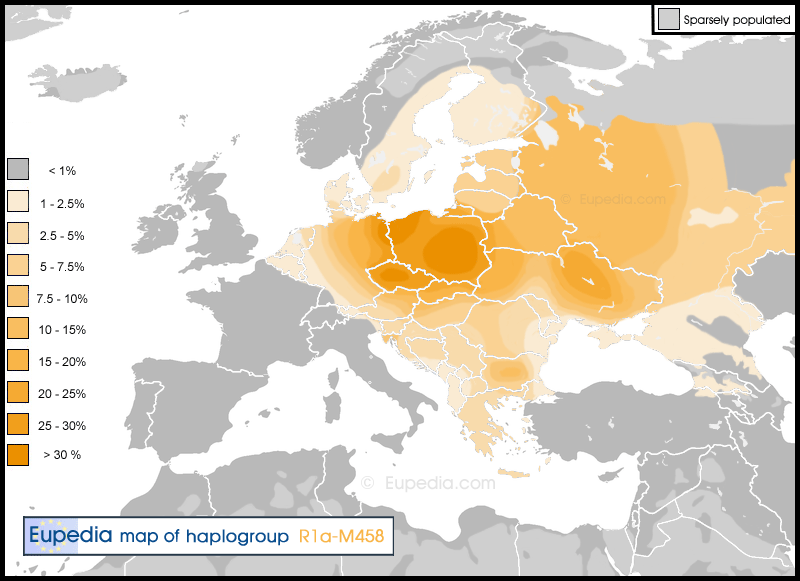


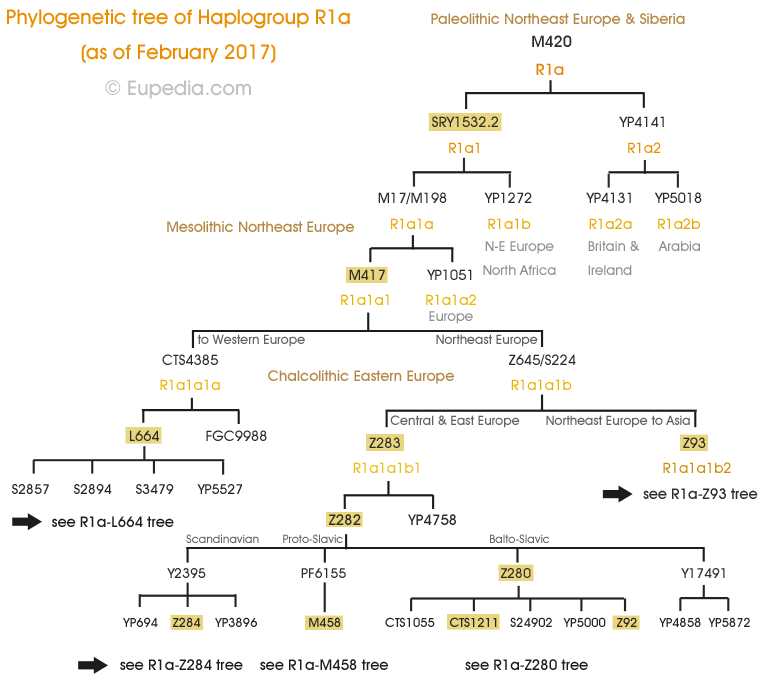
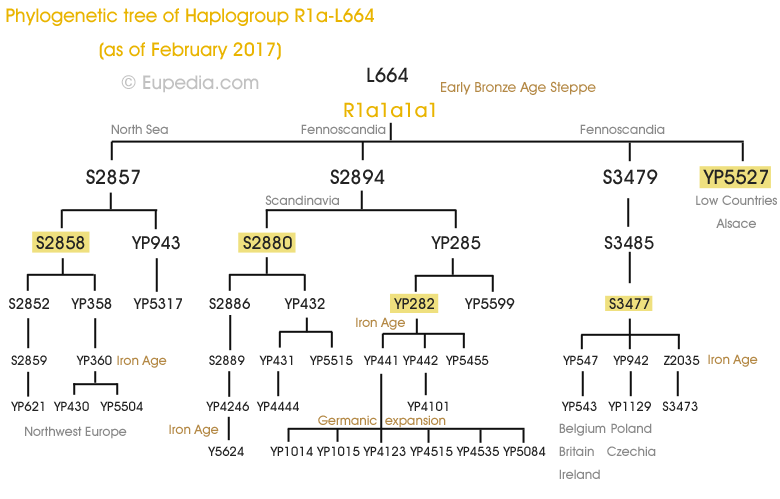
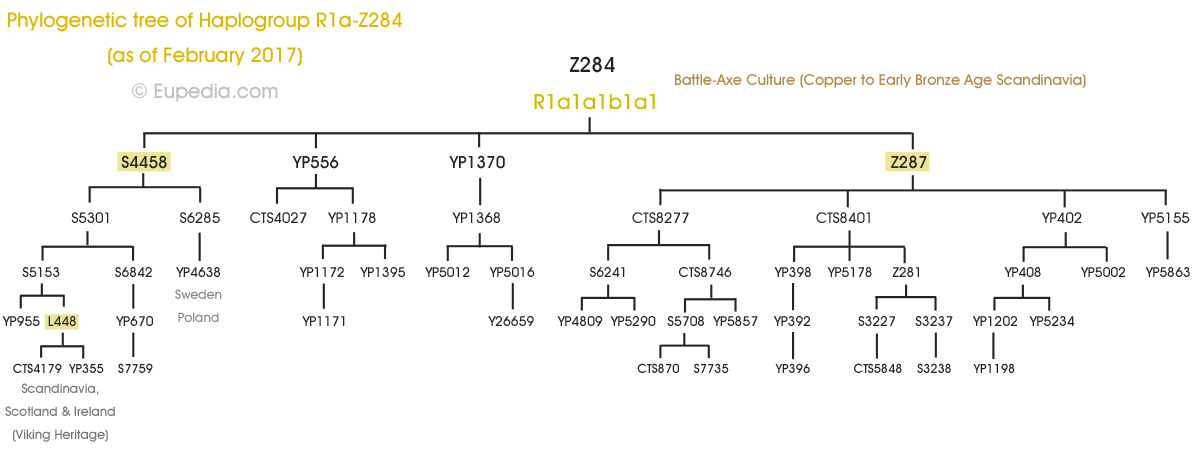
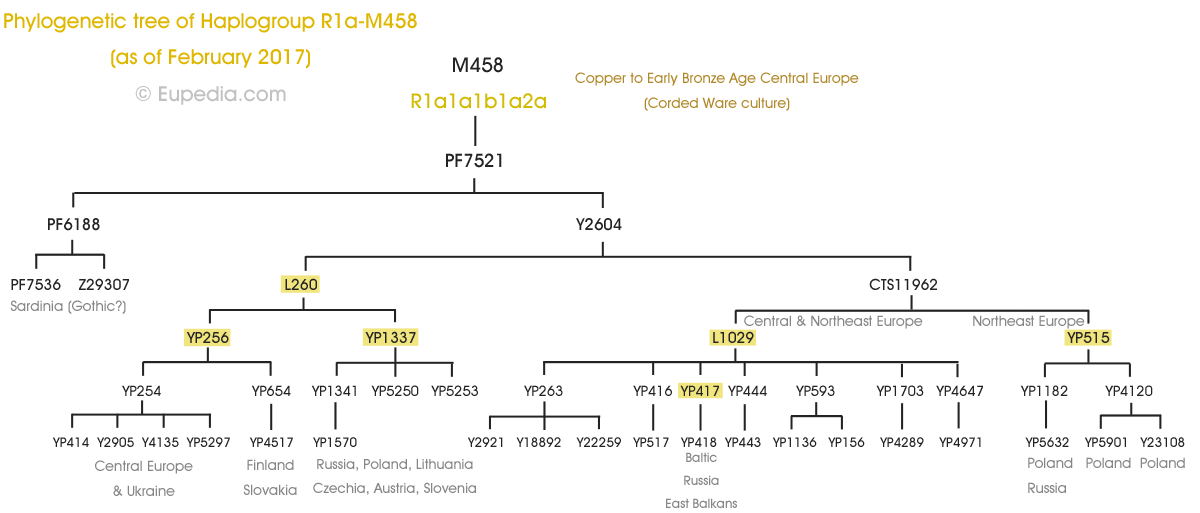
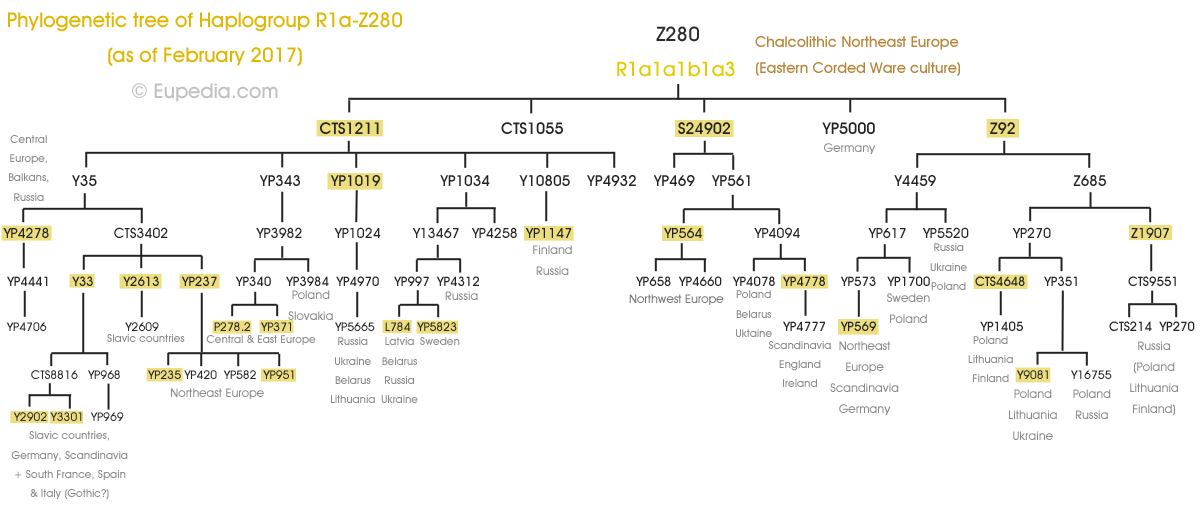


| The Tarim mummies |
|---|
| In 1934 Swedish archaeologist Folke Bergman discovered some 200 mummies of fair-haired Caucasian people in the Tarim Basin in Northwest China (a region known as Xinjiang, East Turkestan or Uyghurstan). The oldest of these mummies date back to 2000 BCE and all 7 male remains tested by Li et al. (2010), were positive for the R1a1 mutations. The modern inhabitants of the Tarim Basin, the Uyghurs, belong both to this R1b-M73 subclade (about 20%) and to R1a1 (about 30%). The first theory about the origins of the Tarim mummies is that a group of early horse riders from the Repin culture (3700-3300 BCE) migrated from the Don-Volga region to the Altai mountain, founding the Afanasevo culture (c. 3600-2400 BCE), whence they moved south to the Tarim Basin. Another possibility is that the Tarim mummies descend from the Proto-Indo-Iranian people (see above) who expanded all over Central Asia around 2000 BCE from the Sintashta-Petrovka culture. An offshoot would have crossed the Tian Shan mountains, ending up in the Tarim Basin. This theory has the merit of matching the dating of the Tarim mummies. Either way, most of the mummies tested for mtDNA belonged to the Mongoloid haplogroup C4, and only a few to European or Middle Eastern haplogroups (H, K and R). There is some controversy regarding the possible link between the Tarim mummies and the Tocharian languages, a Centum branch of the Indo-European family which were spoken in the Tarim Basin from the 3rd to 9th centuries CE. It is easy to assume that the Tarim mummies were Proto-Tocharian speakers due to the corresponding location and the Indo-European connection. However, the Tarim mummies predate the appearance of Tocharian by over two millennia, and Tocharian is a Centum language that cannot be descended from the Satem Proto-Indo-Iranian branch. Other Centum branches being all related to haplogroup R1b, and Tocharian being the only eastern Centum language, it is possible that the Tocharian speakers is instead associated to the Central Asian R1b1b1 (M73) subclade, also found among the modern Uyghurs inhabiting the Tarim basin. |
| Turkic speakers and R1a |
|---|
| The present-day inhabitants of Central Asia, from Xinjiang to Turkey and from the Volga to the Hindu Kush, speak in overwhelming majority Turkic languages. This may be surprising as this corresponds to the region where the Indo-Iranian branch of Indo-European speakers expanded, the Bronze-Age Andronovo culture, and the Iron-Age Scythian territory. So why is it that Indo-European languages only survives in Slavic Russia or in the southern part of Central Asia, in places like Tajikistan, Afghanistan or some parts of Turkmenistan ? Why don't the Uyghurs, Uzbeks, Kazakhs and Kyrgyzs, or the modern Pontic-Caspian steppe people (Crimean Tatars, Nogais, Bashkirs and Chuvashs) speak Indo-European vernaculars ? Genetically these people do carry Indo-European R1a, and to a lesser extent also R1b, lineages. The explanation is that Turkic languages replaced the Iranian tongues of Central Asia between the 4th and 11th century CE. Proto-Turkic originated in Mongolia and southern Siberia with such nomadic tribes as the Xiongnu. It belongs to the Altaic linguistic family, like Mongolian and Manchu (some also include Korean and Japanese, although they share very little vocabulary in common). It is unknown when Proto-Turkic first emerged, but its spread started with the Hunnic migrations westward through the Eurasian steppe and all the way to Europe, only stopped by the boundaries of the Roman Empire. The Huns were the descendants of the Xiongnu. Ancient DNA tests have revealed that the Xiongnu were already a hybrid Eurasian people 2,000 years ago, with mixed European and North-East Asian Y-DNA and mtDNA. Modern inhabitants of the Xiongnu homeland have approximately 90% of Mongolian lineages against 10% of European ones. The oldest identified presence of European mtDNA around Mongolia and Lake Baikal dates back to over 6,000 years ago. It appears that Turkic quickly replaced the Scythian and other Iranian dialects all over Central Asia. Other migratory waves brought more Turkic speakers to Eastern and Central Europe, like the Khazars, the Avars, the Bulgars and the Turks (=> see 5000 years of migrations from the Eurasian steppes to Europe). All of them were in fact Central Asian nomads who had adopted Turkic language, but had little if any Mongolian blood. Turkic invasions therefore contributed more to the diffusion of Indo-European lineages (especially R1a1) than East Asian ones. Turkic languages have not survived in Europe outside the Pontic-Caspian steppe. Bulgarian language, despite being named after a Turkic tribe, is actually a Slavic tongue with a mild Turkic influence. Hungarian, sometimes mistaken for the heir of Hunnic because of its name, is in reality an Uralic language (Magyar). the The dozens of Turkic languages spoken in the world today have a high degree of mutual intelligibility due to their fairly recent common origin and the nomadic nature of its speakers (until recently). Its two main branches Oghuz and Oghur could be seen as two languages about as distant as Spanish and Italian, and languages within each branch like regional dialects of Spanish and Italian. |
mislim da je Vasojevicka EV13 "evropskija" nego siptarska R1bby611Чини ми се да је то основни проблем, што се за скуп младих подграна користи назив хаплогрупе која је десетинама хиљада година старија, због чега неки мање упућени почињу кобиновати одређене хаплогрупе с одређеним историјским или савременим популацијама. Чак се ни подране не могу тако уско посматрати, а камоли целе хаплогрупе.
| Haplogroup E1b1b (Y-DNA) |
|---|

| Contents |
|---|






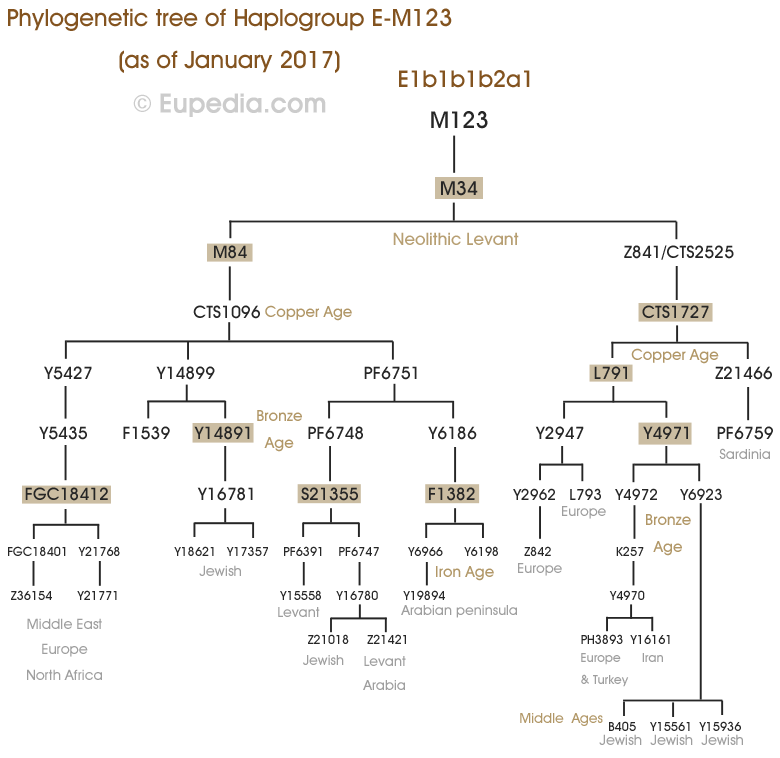
Složio bih se sa ovim.Vecina istoricara vjeruje da E se sirilo sa anticko-grckim trgovcima po mediteranu. Vjerovao bih da je E starosjedilacki grcki "mikenski" marker, i da kasnije dio ovog stanovnistva romanizovano i sirilo se sa balkanskim vlasima. Kasnije ovi vlasi su asimilirani u Srbe i Albance i eto danasnja E plemena.
Recimo u vezi plemena Kuča. Najvjerovatniji rodonacelnik Kuča se zove Petar Kuč koji se pominje dva puta u poveljama 1320 i 1330 godine u Katunu Ljesa Tuza sjeverno od Skadra. Genetika i dokazuje da zajednicki predak svih Kuca seze otprilike do ovog perioda.
Naziv "kuč" je romansko-vlaskog porijekla od vulgarne latinske rijeci "cocceus" za crveno. Na albanskom je ovo izgovoreno drugacije "Kuq" (Kuć) sto je isto pozajmica od latinske rijeci. Dakle rodonacelnik Petar Kuč, ili Petar Crveni najvjerovatnije je bio Roman ili vec Polu-slovenizirani roman koji je zivio medju slovenskim i albanskim stanovnistvom.
Rogobatan izraz, ne znam kako da ti sročim odgovor, a da ne izađe iz okvira.mislim da je Vasojevicka EV13 "evropskija" nego siptarska R1bby611
Složio bih se sa ovim.
Mada, ima još jedna interesantna teza.
Naime prezime kuč se javlja širom slovenskog sveta, postoji i lingvistička podloga koja bi mogla eventulno dokazati da se radi o slovenskoj reči.
Konto toga u staro Kučima postoje R1a i I2a.
Jedino je za najveći i najorganizovaniji rod u Kučima,Kuče Drekaloviće izvesno da su E-V13 i da su svi istog porekla.
Vasojevići imaju neka poklapanja po Poljskoj, takođe njihova podgrana je udaljena od kuča i bjelopavlića 4000 godina. Neke E1b grane se javljaju i kod Rusina.
U svakom slučaju treba biti oprezan.
Slažem se da je mnogo logičnija romanska verzija.To sam gledao u onoj SrbijaGlobal emisiji. Mora se provjeriti i ta prezimena, da nijesu potomci doseljenika sa Balkana (bilo je puno srpskih kolonija po Ukrajini i doseljavanja u Rusiji).
Sta bi bilo znacenje rijeci "Kuč" na tim slovenskim jezicima?
Mora se prisjetiti da ime "Kuč" najvjerovatnije je bilo licno ime ili nadimak, s'obzirom da su Drekalovici i novo Kuci istog pretka. Tako da teorija o Kucima kao stara geografska odrednica ili kao staroslovenska rijec za "kuća" ili "ker" ne bi imalo toliko smisla.
Dodamo i saznanja o "Petrom Kucu" kao i cinjenica da arbanski dio plemena Kuca se zove "Koći", mogucnost vlaskog porijekla imena "Kuc" po cocceus je vjerovatnija i logicnija.
Mislim da je potvrdjeno da su i Drekalovici i staro Kuci istog roda, E-V13.
Normalno. Ako kod Rusina, i juzne Poljske, odnosno Zakarpatije onda opet govorimo o mijesano romansko-vlaskoj teritoriji.
Slažem se da je mnogo logičnija romanska verzija.
Međutim postoji i ova teza koju sam gore izneo.
Staro Kuči koji su testirani imaju nešto R1a, mada to nije( barem za moje znanje) tako detaljno obrađeno i neki zvanični zaključak nije donesen.
Moguće da su ti R1a doseljenici u staro kuče.
Ima raznih toponima sličnim kuč, npr Kučevo itd.
To bi trebalo da znači prostor iza ili znad Kuće.
Na kraju krajeva bilo koja teza da je tačna to ne menja puno. Oni su svakako prve etničke, narodne, a kasnije i nacionalne osećaje razvili kao Srbi.
hteo sam da uporedim odnos recimo Vasojevicke grane EV13 i neke istocne R1b, koliko moze da bude daleko od zapadne R1b a nominalno su ista haplogrupa.Rogobatan izraz, ne znam kako da ti sročim odgovor, a da ne izađe iz okvira.
E-V13 koja je kod Vasojevića, javlja se dugo unazad svuda po evropi. U tom kontekstu se može posmatrati kao nešto manje mediteranska u odnosu na nege druge grane E1b.
Inače haplogrupa ne može biti ,,evropskija".
Pretpostavljam da si mislio na neko poređenje Vasojevića sa Albancima? U kontekstu toga, Vasojevići su Srbi i verovatno dosta rano ulaze u srpski etnos, a kod Srba gotovo da i nema ne evropskih primesa bez obzira na haplogrupu.
Kod Albanaca je slučaj ,,egzotične" genetike učestaliji, mada ne toliko koliko bi se možda moglo očekivati. Uostalom postoje neka plemena koja su turskog porekla kada su Albanci u pitanju.
